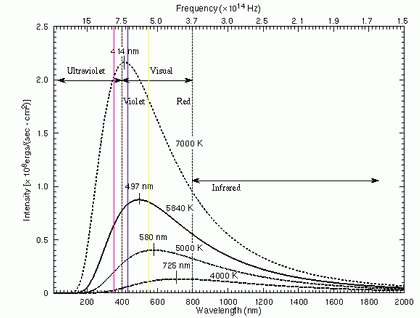|
|
|
 |
|
 |
Navigation: Contents: Info: WESSELINK'S
METHOD FOR DETERMINATION OF THE RADIUS OF CEPHEID
VARIABLES The Cepheid pulsation theory can be
tested by observations of brightness, colour, and radial
velocity; this test leads to a determination of the mean
radius of a star as an absolute value. The observed colour
provides the surface brightness (assuming it acts as a black
body), and, by division, the area then follows as an
arbitary value. Hence the radius becomes known as a function
of the phase. Variations in the radius may be found by
integration of the velocity curve as a function of
time. THE COLOUR INDEX This is the difference between the
magnitude measured in one wavelength band and its magnitude
in another. The most popular system in use is the
UBV system. Three wide spectral bands are used called U, B
and V. The UBV bands are:- The colour index of a star can be
computed easily by taking the magnitudes in one wavelength
from another. For example B-V is very useful because it can
quickly give the spectral type of a star when using the
Hertzsprung-Russell diagram. Stellar magnitudes decrease
with increasing brightness, so a star with a small (B-V)
colour index is bluer than a star with a higher (B-V) index.
In other words, a small B-V index means the star is hotter
than a large B-V index. Continous spectra for stars at
different temperatures showing the wavelength bands of the U
(purple),
B (blue)
and V (yellow)
photometric system. As a Cepheid variable pulsates in and
out, its surface heats and cools giving a different colour
index for different times. This change in the colour index
can be plotted over time to show the variability of the
stars temperature. THE LIGHT CURVE This is simply a plot of the stars
change in magnitude over a period of time. It is very useful
for determining the period of the star. RADIAL VELOCITY The radial velocity of an object can
be determined by using spectral analysis. A Cepheid variable
pulsates in and out, and as it does so the outer layer of
atmosphere approaches and recedes with respect to the
observer. When this happens, the spectral lines from the
star move backwards and forwards. When the lines move
towards the red end of the spectrum, the stars atmosphere is
receding; the star is contracting . When they move towards
the blue end of the spectrum, the stars atmosphere is
approaching the observer; the star is expanding. This diagram shows the movement of
the spectral lines from a pulsating
star When the change in wavelength is
measured it gives the velocity that the star is expanding or
contracting with. If this velocity is plotted as a function
of time the result it a radial velocity curve. The two
assumptions: At any moment, a spherical star varies
periodically in both radius and brightness. At two phases on the light curve where
the colours are the same, the absolute distribution of
energy is also the same (but with different
magnitudes). So for these two points:- Dividing the first by the second
gives:- The use of the Colour Index
curve. But if the colours at these two times
are the same, then so must the temperature be.
Therefore:- The use of the Light
Curve. Now if at times If we let the right hand side of this
equation be equal to N then we have:- And so:- Giving:- The use of the Radial
Velocity curve. Now it is known that the true velocity
of the stellar surface is Where The change in radius from So combining equation one with two
gives:- Thus by using a combination of data
(the light curve, colour curve and velocity curve) the
radius of a pulsating star can be determined at two or more
particular times.

 RED
RED
![]()
![]()


![]() and
and![]() ,
the apparent magnitudes are
,
the apparent magnitudes are ![]() and
and
![]() respectively,
Pogsons equation gives us:-
respectively,
Pogsons equation gives us:-



![]() times
the measured velocity, so we could write:-
times
the measured velocity, so we could write:-
![]() is
the measured radial velocity. Therefore:-
is
the measured radial velocity. Therefore:-
![]() to
to
![]() can be
expressed as:-
can be
expressed as:-
 and
and
Exercise-Determine
The Radius Of Eta Aquilae
[ QUANTUMWEB SOFTWARE | QUANTUMWEB PUBLISHING ]